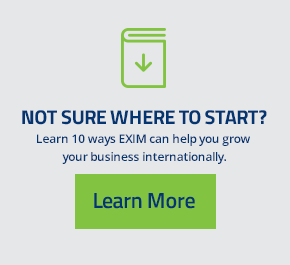It’s important to understand that the key to good market research is agreeing on what success looks like. Are you entering a global market to increase sales by X percent, increase profit by X percent, increase awareness or educate on Y product, or to introduce a brand new product or spin-off of an existing one? These are all questions you need to try to answer as you begin to perform your market research. There are trade agencies that can help you find these answers such as the Department of Commerce and Export-Import Bank of the U.S. Below you’ll find a simple market research process outlined:
What is your product’s classification number?- What is your product’s “Schedule B” number or Harmonized System (HS) number? The potential exported product needs to be identified and classified before any research can be done. Use this Census Bureau site to search and find your export classification category.
Where are your potential markets? Which countries already import your product?
- Export.gov’s Market Intelligence – A re-vamped site that allows you to learn about your product’s potential in a global market.
- TradeStats Express – This site provides broad national trade and state export statistical data represented in charts and maps. This is useful when you need general information.
- U.S. International Trade Commission Trade Data Web - A source for U.S. import and export data per product or by customized list. This site allows you to create a spreadsheet sorted by value, percent change, Harmonized System number, and so on.
- UN Comtrade – This site is free and it’s a repository of official trade statistics containing annual trade stats starting all the way back from 1962. It can also be used to find information on potential competitors.
Do you fall under one of the Free Trade Agreements?
- Rules of Origin – If your product was manufactured in the U.S. or an approved “Free-Trade Agreement (FTA)” territory, you may fall under one of the 20 Free Trade Agreements which may benefit you regarding lower duties and/or lower overall costs.
Now that the product has been identified and the top markets are known, who are your competitors
- USA Trade Online - A Census site that is free, but you must register to get access to export market data.
What are the associated taxes/fees/barriers?
- Customs Info Database – Users of this site can use this free service to look up shipment information related to tariffs.
- FTA Tariff Tool - This site incorporates all products (agricultural and non-agricultural goods) and includes information on product-specific rules of origin to determine if you quality for reduced tariff rates.
Other useful links that can be used for market research include:
- ITA’s Top Market Reports –Find top market assessments by industries such as manufacturing and technology, aircraft parts, agricultural equipment and so on.
- Country Commercial Guides – Use these guides to help you better understand market conditions, opportunities, challenges and regulations surrounding a specific country. These reports are prepared by trade/ industry experts in U.S. embassies across the globe.
- IMF or World Bank – Good sources to get information on other potential market factors such as GDP, stability, ease of doing business, etc.
Wondering how the Export-Import Bank can help you?
The EXIM Bank provides financial tools to help small businesses boost export sales, be more competitive in the global market and be prepared when negotiating competitive credit terms with their foreign buyers. To find out more about how we can help, download our Export Expertise eBook: 10 Finance Tools to Grow Your Export Business.
